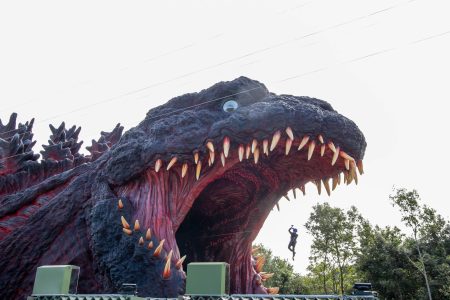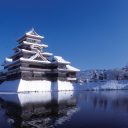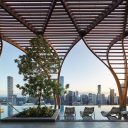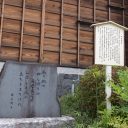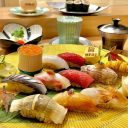Learner’s Stories Vol.2
The IJSP Program For International Study December 2019
In December 2019, students from the Japan Foundation, Sydney’s J-Course traveled to Ishikawa, Japan to take part in the Ishikawa Japanese Studies Program for Individuals. During the two week stay, the students studied Japanese intensively, experienced everyday Japanese life living with a homestay family, tried cultural activities, and explored beautiful Ishikawa prefecture.

Ishikawa Prefecture is located along the coast of the Sea of Japan in central Japan, roughly three hours from Tokyo by bullet train, and is famous for its capital city Kanazawa (one of Japan’s best-preserved samurai towns), traditional crafts including gold leaf, and its natural beauty.
This program was conducted by the Ishikawa Foundation for International Exchange and is not affiliated with the Japan Foundation, Sydney. More information about the program is available at ifie.or.jp/ijsc/ijsp
TONY OESTERHELD
(PRE-INTERMEDIATE COURSE AT JF SYDNEY)

In the JF October holidays last year, I applied for the above two week program for Japanese language study in Kanazawa, commencing Dec 8, 2019. The window to apply and notice given are short, so decisions have to be made quickly. Fortunately, the timing suited me and to my pleasant surprise, I was accepted.
The experience is part of what is called a homestay program where you live with a Japanese family, giving you the opportunity to communicate in Japanese and to experience Japanese lifestyle and culture first hand and to get a sense of the rhythms of everyday domestic life.
The study program at the Language School is for three hours with breaks every weekday morning. Some afternoons, there are cultural activities and on this schedule there was a visit to the Kenroku-en Garden, very beautiful, even in winter, a practical and enjoyable workshop on making especially sweet Japanese sweets, a specialty of Kanazawa, doing gold leafing (Kanazawa produces 99% of Japan’s gold leaf) and making good luck woven charms, known as Mizuhiki ornaments. Getting dressed up in traditional (3 layered) kimonos was also part of the cultural activities and I have included a picture of our group.

The profile of students was 4 Brazilians (Brazil has the largest Japanese descent population outside of Japan), 4 Australians, (all from JF), 2 Swiss, 1 German and 1 Pole. The ages varied from 25 years to 77 years, some are incumbent workers and some are retirees. We all got along well. There were only 12 students on this program and we were divided into sub-classes of between 2 and 4 students following an entrance exam; I was in a class with two other students, both from Switzerland, Marcel and Luciana who did not know each other. Their first language was Suisse-Deutsche although their English was excellent; they were good companions and we often had lunch together in the Omicho market restaurants.
Our lessons, due to class size, were virtually private lessons in which we would deliver prepared speeches and ask each other questions. The classes are conversational, fun and highly interactive. Our class had two teachers who took alternate days and they were very skilled at getting s students to talk and sometimes extracting conversation from us, when required. The lessons were always delivered in excellent good spirits.

The homestay family that I stayed with was a family of two with a mother and her 22 year old son. Other students had different sized families, the language school administration tries to match as closely as possible families and students from the detailed application forms. On the weekends, we went for walks with my homestay ‘mother’s’ friends in the hills above the Higashi Chaya district, helped make a gradation of different coloured leaves with friends and their children, had afternoon tea and did some shopping, buying てぬぐい (tenugui; a Japanese cloth) おみやげ (omiyage; souvenirs) in the historic district. It was relaxed and enjoyable. Every student’s experience was different but I considered myself lucky to get the hospitable and kind family that I did.
To communicate with my homestay family was quite a challenge, no doubt. Fortunately, it does improve and being constantly surrounded by Japanese words and sounds helps although it can be a little frustrating. You seem to get better without being conscious of it happening, quite mysterious.
Lastly, Kanazawa is an attractive city, situated close to the seaside on the Northwest of the Ishikawa prefecture. The city is about 15% larger than Canberra, is wealthy and has a number of excellent museums. I visited the Noh, D T Suzuki and Dolls museums and all had real cultural interest. The Ninja Temple is also a fascinating example of a nobleman’s house and the security he required and how his home is structured around his safety.
Overall, I think these programs are a great way to mix with Japanese people and learn about their culture and language. An additional benefit is to get to know your fellow JF students better in a relaxed atmosphere of mutual interest.

CONSTANCE ELLWOOD
(INTERMEDIATE 1 COURSE AT JF SYDNEY)

Last December I participated in a two week course run by the Ishikawa Foundation for International Exchange (IFIE) in Kanazawa. The program for individuals means you don’t have to be part of a university or school group, which is the kind of course IFIE normally runs, but can apply as an individual. This was the first time a course for individuals had been offered. The second one is coming up in April 2020.
Our program provided language classes in the morning, cultural activities on some afternoons, a homestay, a text book, plus transport costs to and from school. We also got a card for discounted access to many of the museums in the city. For 70,000 yen it was great value.
Twelve people applied – four Australians (all from JF, and from different class levels), four Brazilians, two Swiss Germans, one German and one Pole. Age range was late 20s to 70s. After a written test and a self-introduction in Japanese, we were divided into four classes.

My class of four had two great teachers who alternated days and worked from a textbook which gave us lots of speaking practice and plenty of homework to drill the new structures. We had to give a speech every second day. That was intense; I haven’t had to stay up to 11pm doing homework for quite a few decades…. Of course it was worth the agony.
For lunch we often went off in groups to restaurants or to wander around. Some days we would go on a cultural excursion in the afternoon. One day we went to the gorgeous Kenrokuen Garden and to an abbreviated chanoyu ceremony there. Other excursions were kimono wearing, sweets-making, mizuhiki and kinpaku (gold leaf application). On the excursions there was always lots of photograph-taking by one of the IFIE staff. Our presence in Kanazawa was extremely well-documented.
My homestay was unquestionably a great experience. My homestay mother was about my age and we had a lot in common, especially in terms of liking to engage in creative activities and go to onsen. She taught me mizuhiki on my second night there, and took me to three onsen in those two weeks! She has been hosting homestay students for many years and was completely at ease with it. She knew I would be equally interested in the cut-price supermarket, her taiko class, the used-kimono shop and the scenic wonders of Noto Peninsula. She was also very generous and thoughtful. We had a late night shopping expedition to Don Quixote to buy scales so she could weigh herself and I could weigh my luggage. And she was patient with my Japanese.
Kanazawa is a great place to be, not only for what is in the city, but for what is nearby. Two weeks was too short; I am inspired to go back for a longer stay.




HANS KESSLER
(ELEMENTARY 2 COURSE AT JF SYDNEY)

First and foremost, I have to say that the Ishikawa Foundation for International Exchange (IFIE) program is a marvellous experience that given the opportunity I would gladly do again.
The course is well organised and runs like clockwork, you can tell the staff and organisers have been doing this for a long time and have the entire program from intake and initial contact through to final farewells working perfectly.
We had a small group of twelve participants from Australia, Brazil, Germany, Poland & Switzerland. After the first day which consisted of a grading exam, we were split into four classes, each class having between two and three students. You get very focused tuition and given the small class size there nowhere to hide. Each morning was filled with three hours of tuition. About half the afternoons were taken up with excursions to various “Kanazawa” specialities, such as the Kenrokuen Garden, making Okashi and Mizuhiki amongst other activities.
Kanazawa has the reputation of being one of the wettest places in Japan, we were particularly lucky and had a smattering of rain on only a couple of days. In the past five years Kanazawa has become more of a destination for traveling to, with the opening of a direct Shinkanzen. Having said that though, there’s a distinct lack of tourists to be seen on the streets and walking around the town, you can enjoy most parts of the town relatively tourist free.

The city of Kanazawa has some stand out attractions, the foremost been the Kenrokuen Garden, originally the outer garden of the Kanazawa Castle and opened to the public in the 1800’s. It’s rated as one of the three great gardens of Japan, and you can certainly see why. I think we can all be very grateful that the 江戸時代 (edo jidai; the Edo period) took place and allowed 大名 (daimyō; feudal lords) to devote time to pursuits such as building beautiful gardens, places such as this give us a glimpse of what the floating world must have been like.
Other than the tuition, the other integral part of the IFIE program is the homestay. Most of the participants in the group I studied with had extremely good experiences. The IFIE does everything they can to ensure that everything goes well. Staying with a host family gives you far more exposure to true Japanese homelife.
In conclusion, I would strongly recommend all Japan Foundation students to take up the opportunity to attend the IFIE program if the opportunity presents itself. The teaching is excellent, and Kanazawa is a lovely city. I’ll certainly be trying to attend another course if the program keeps going and I have the time to attend.

— Article From THE JAPAN FOUNDATION, SYDNEY

